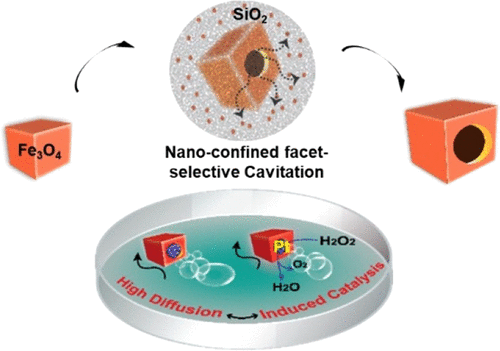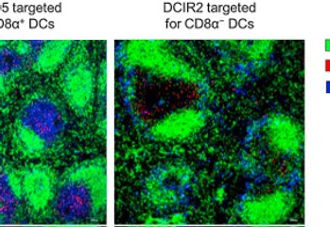








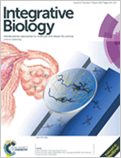
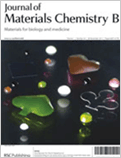


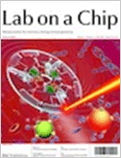

[101] ACS Nano, 2020, accepted
The 3D microfluidic human liver-chip developed in this study demonstrates how breast cancer-derived extracellular vesicles induce the formation of a pre-metastatic niche, promoting the adhesion of circulating tumor cells to a distant organ such as the liver, enabling the investigation of cancer metastasis and a wide range of potential pharmacological therapies.

Copy Of -[101] ACS Nano, 2020, accepted
The 3D microfluidic human liver-chip developed in this study demonstrates how breast cancer-derived extracellular vesicles induce the formation of a pre-metastatic niche, promoting the adhesion of circulating tumor cells to a distant organ such as the liver, enabling the investigation of cancer metastasis and a wide range of potential pharmacological therapies.
Reactions give solvents a kick
During a chemical reaction, the reorganization of solvent molecules not directly in contact with reactants and products is normally viewed as a simple diffusion response. Wang et al. studied molecular diffusion in six common reactions—including the copper-catalyzed click reaction and the Diels-Alder reaction—with pulsed-field gradient nuclear magnetic resonance. They observed a boost in mobility relative to Brownian diffusion that was stronger for the catalyzed reactions that were studied. The mobilities for the click reaction were verified with a microfluidic gradient method. They argue that energy release produces transient translational motion of reacting centers that mechanically perturbs solvent molecules.
Here, we cultured cells on various protruded convex structures such as triangle, square, and circle shape fabricated using two-photon laser lithography and quantitatively analyzed individual cells. We found that intermediate filaments, vimentin, and cytokeratin 8/18, play important roles in the growth and adaptation of epithelial cells by enhancing expression level on convex structure depending on the shape. In addition, microtubule building blocks, α-tubulin, was also responded on geometric structure, which indicates that intermediate filaments and microtubules can cooperatively secure the mechanical stability of epithelial cells on the convex surface. Altogether, the current study will expand our understanding of mechanical adaptations of cells on out-of-plane geometry.
Here, we describe a custom-made fidget spinner that rapidly concentrates pathogens in 1-ml samples of undiluted urine by more than 100-fold for the on-device colorimetric detection of bacterial load and pathogen identification. The device enabled the on-site detection of infection with the naked eye within 50 min in urine samples from 39 patients suspected of having a urinary tract infection. We also show that, in 30 clinical samples of urinary tract infection, the device can be used to perform an antimicrobial susceptibility test for the antimicrobial drugs ciprofloxacin and cefazolin within 120 min. The fidget spinner could be used in low-resource settings as an inexpensive handheld point-of-care device for the rapid concentration and detection of pathogens in urine samples.
This pilot study of 13 patients with ovarian cancer aimed to investigate a strategy for the enumeration and detection of CTCs based on a newly-developed centrifugal microfluidic device equipped with a fluid-assisted separation technology (FAST) disc and to demonstrate the correlations among CTC counts from the new device, CA125 concentrations, and clinical course of the disease.
Paramount interest and challenges remain in designing and synthesizing catalysts with nature‐like complexities at few‐nm scale to harness unprecedented functionalities by using sustainable solar light. We introduce “nanocatalosomes”— bio‐inspired bilayer‐vesicular design of nanoreactor with metallic bilayer hollow shell‐in‐shell structure, having numerous controllable confined cavities within few‐nm interlayer space, customizable with different noble metals. This work paves the way towards next‐generation nanoreactors, craftable at few‐nm scale to maximize their functionality and customizable to carry out diverse chemical transformations efficiently with green solar energy.
Here, we introduce EV-Ident for preparation of subpopulations of EVs in three different size fractions: large EVs (EV200 nm; 200−1,000 nm), medium EVs (EV100 nm; 100−200 nm), and small EVs (EV20 nm; 20−100 nm). As a proof-of-concept, we analyzed the presence of human epidermal growth factor receptor 2 (HER2) and prostate-specific membrane antigen (PSMA) in breast cancer and prostate cancer cell-derived EVs, respectively, using three different size fractions at the single-EV level. By reducing the complexity of EV heterogeneity in each size fraction, we found that HER2-positive breast cancer cells showed the greatest expression of HER2 in EV20 nm, whereas PSMA expression was the highest in EV200 nm derived from PSMA expressing prostate cancer cells. This increase in HER2 expression in EV20 nm and PSMA expression in EV200 nm was further confirmed in plasma-derived nanoparticles (PNPs) obtained from breast and prostate cancer patients, respectively.
Here, we show that mixed-charge nanoparticles covered with certain ratios of positively and negatively charged ligands can selectively target lysosomes in cancerous cells while exhibiting only marginal cytotoxicity towards normal cells. This selectivity results from distinct pH-dependent aggregation events, starting from the formation of small, endocytosis-prone clusters at cell surfaces and ending with the formation of large and well-ordered nanoparticle assemblies and crystals inside cancer lysosomes. These assemblies cannot be cleared by exocytosis and cause lysosome swelling, which gradually disrupts the integrity of lysosomal membranes, ultimately impairing lysosomal functions and triggering cell death.
[93] Theranostics, 2020, 0(12):5181-5194. doi:10.7150/thno.44693
The change ratio of the CTC counts was associated with tumor response, detected by CT scan, while the baseline CTC counts did not show association with progression-free survival or overall survival. We achieved a 100% concordance rate for the detection of EGFR mutation, including the emergence of T790M, between tumor tissue and CTCs. More importantly, our data revealed the importance of the analysis of the epithelial/mesenchymal signature of individual pretreatment CTCs to predict drug responsiveness in patients. The fluid-assisted separation technology disc platform enables serial monitoring of CTC counts, DNA mutations, as well as unbiased molecular characterization of individual CTCs associated with tumor progression during targeted therapy.
Here, we investigate the CTC capture abilities of two technologies that are not dependent on cell‐surface marker expression: a selection‐free platform, the AccuCyte®‐CyteFinder® system (Rarecyte) and a size‐based platform, the fluid‐assisted separation technology (FAST). The combination of the two systems to more completely assess CTCs was investigated.
Herein, we describe a fully automated lab-on-a-disc-based method of platelet isolation from a small volume of blood (<1 mL). This method provides higher yields (>4 folds) and purity (>99%) and lower platelet activation than the conventional method. Moreover, it was also superior in the detection of platelet-related RNAs CD41, PF4, and P2Y12 due to lower contamination with white blood cells.
Herein, we report on a direct-write 3D NFES technique to construct self-aligned, template-free, 3D stacked nanoarchitectures by simply adding salt to the polymer solution. Numerical simulations suggested that the electric field could be tuned to achieve self-aligned nanofibers by adjusting the conductivity of the polymer solution. We demonstrate the 3D printing of nanoskyscrapers with various designs, such as curved “nanowall arrays”, nano “jungle gyms,” and “nanobridges”. Further, we present an application of the 3D stacked nanofiber arrays by preparing transparent and flexible polydimethylsiloxane films embedded with Ag-sputtered nanowalls as 3D nanoelectrodes. The conductivity of the nanoelectrodes can be precisely tuned by adjusting the number of 3D printed layers, without sacrificing transmittance. The current NFES approach provides a simple, reliable route to build 3D stacked nanoarchitectures with high-aspect ratios for potential applications in smart materials, energy devices, and biomedical applications.
Transmitted light microscopy can readily visualize the morphology of living cells. Here, we introduce artificial-intelligence-powered transmitted light microscopy (AIM) for subcellular structure identification and labeling-free functional analysis of live cells. AIM provides accurate images of subcellular organelles; allows identification of cellular and functional characteristics (cell type, viability, and maturation stage); and facilitates live cell tracking and multimodality analysis of immune cells in their native form without labeling.
We propose an electrochemical sensor based on the enhanced electrocatalytic oxidation exhibited on a functionalized poly(tannic acid) coating to detect hydrazine. Tannic acid, a naturally abundant and low-cost polyphenol, was enzymatically polymerized with horseradish peroxidase and subsequently adsorbed on a disposable, screen-printed carbon electrode with a short incubation time (30 min). The fabrication method proved to be reproducible (4.2% relative standard deviation), with the sensors displaying high sensitivity (7 × 10-3 µA·mm-2·µM-1) and selectivity even in the presence of various common interfering agents. The low detection limit (100 nM) and robustness of the sensor demonstrated its suitability for environmental applications. It can be used to quantify hydrazine in tap and river water samples.
The possibility of functional roles played by platelets in close alliance with cancer cells has inspired the design of new biomimetic systems that exploit platelet–cancer cell interactions. Here, the role of platelets in cancer diagnostics is leveraged to design a microfluidic platform capable of detecting cancer‐derived extracellular vesicles (EVs) from ultrasmall volumes (1 µL) of human plasma samples. Further, the captured EVs are counted by direct optical coding of plasmonic nanoprobes modified with EV‐specific antibodies. Owing to the diverse function proteins associated with human platelets that can bind to the wide spectrum of cancer cell-derived extracellular vesicles, the resulting microdevice is capable for sensitive and accurate detection of cancer from ultra-small volumes of patient’s plasma samples.
We investigate the effects of poly(ethylene glycol) (PEG) doping on nematic lyotropic chromonic liquid crystals (LCLCs) confined in a cylindrical cavity. We also confirm that the grafting of PEG to bare glass surfaces changes them from nemato-philic to nemato-phobic. Additionally, we observe that PEG-doped nematic SSY retains the double-twist director configuration as in the PEG-free case. However, the PEG-doped nematic SSY is accompanied by unprecedented domain-wall-like defects and heterogeneity in the director configuration. We propose multiple hypotheses on how PEG changes the director configuration, including the formation of meta-stable director configurations.
Circulating tumor cells (CTCs) in the blood have been used as diagnostic markers in patients with colorectal cancer (CRC). In this study, we evaluated a CTC detection system based on cell size to assess CTCs and their potential as early diagnostic and prognostic biomarkers for CRC
The challenge lies in understanding the recruitment of immune cells to the tumor site with the contradictory outcomes: tumor reduction or progression. The movement of immature dendritic cells, which navigate and sample the environment before activating the immune response, is random by nature, and recognizing the effective chemotactic cues towards cancer among a myriad of cytokines present in the surroundings is finding a needle in a haystack. In this paper, we find imposing physical constraints in the cell migration tracks in the geometry and dimensions modulates the directional persistence of dendritic cells. A delicate balance between chemotactic cues and the physical confinements reveals subtle chemotactic differences of dendritic cells in cancer vs. normal cell surroundings even inside a complex maze.
Herein, we report a cell-membrane-modified field effect transistor (FET) as a function-based nanosensor for the detection and quantitative measurement of numerous toxins and biological samples. By coating carbon nanotube FETs with natural red blood cell membranes, the resulting biomimetic nanosensor can selectively interact with and absorb broad-spectrum hemolytic toxins regardless of their molecular structures. Toxin–biomembrane interactions alter the local charge distribution at the FET surface in an ultrasensitive and concentration-dependent manner, resulting in a detection limit down to the femtomolar (fM) range.
Lab-on-a-disc equipped with sequential nanofiltration is presented for fully automated, rapid, label-free EV enrichment with high yield and purity starting from whole blood or plasma for cancer diagnosis and monitoring.
We demonstrate a method to prepare giant unilamellar vesicles (GUVs) with biologically-active protein activity, by mixing erythrocyte (red blood cell) membrane extract with phospholipids and growing their mixture in a porous hydrogel matrix. This presents a pathway to retain protein biological activity without prior isolation and purification of the protein.
This HRP-catalyzed polymerization of TA and p(TA)-mediated surface modification method can provide a simple and new framework to construct multifunctional platforms for covalent attachment of biomolecules and development of sensitive electrochemical sensing devices
Artificial nanoreactors that can facilitate catalysis in living systems on-demand with the aid of remotely operable and biocompatible energy-source, are needed to leverage the chemical diversity and expediency of advanced chemical synthesis in biology and medicine. Here, we designed and synthesized plasmonically-integrated nanoreactors (PINERs) with highly tunable structure and NIR-light-induced synergistic function for efficiently promoting unnatural catalytic reactions inside living cells.
Androgen receptor splice variant 7 (AR-V7) is associated with castration-resistant prostate cancer (CRPC) and resistance to anti-androgen therapy. Herein, we suggest a practical and non-invasive liquid biopsy method for analysis of AR-V7 in the RNA of urine-derived extracellular vesicles (EVs) without the need for blood withdrawal. Higher AR-V7 and lower AR-FL expression were detected in urine-derived EVs from 14 patients with CRPC than in those from 22 patients with hormone-sensitive prostate cancer. This study is the first to report that RNA of urine-derived EVs is a reliable source for AR-V7 expression analysis. The proposed method for quantifying AR-V7 in urinary EVs prepared by a lab-on-a-disc is, therefore, a simple and promising approach to liquid biopsy with great potential for therapeutic impact on prostate cancer.
Esophageal squamous cell carcinoma (ESCC) is one of the aggressive gastrointestinal tract cancers. Detection of circulating tumor cells (CTCs) in peripheral blood from patients with various malignancies has been reported to have diagnostic, prognostic, and therapeutic implications. We aimed to evaluate CTCs in patients with ESCC and assess the clinical significance of CTCs in the early diagnosis of ESCC.
Catalysis and mobility of reactants in fluid are normally thought to be decoupled. Violating this classical paradigm, this paper presents the catalyst laws of motion. Comparing experimental data to the theory presented here, we conclude that part of the free energy released by chemical reaction is channeled into driving catalysts to execute wormlike trajectories by piconewton forces performing work of a few kBT against fluid viscosity, where the rotational diffusion rate dictates the trajectory persistence length. This active motion agitates the fluid medium and produces antichemotaxis, the migration of catalyst down the gradient of the reactant concentration. Alternative explanations of enhanced catalyst mobility are examined critically.
The Janus-type concave iron oxide nanocube was further functionalized with the controllable density of catalytic Pt-nanocrystals exclusively on concave sites and utilized as a highly diffusive catalytic Janus nano-swimmer for the efficient degradation of pollutant-dyes in water. The strategy is based on a novel heat-induced nanospace-confined domino-type migration of Fe2+ions from the SiO2–Fe3O4 interface toward the surrounding silica shell and concomitant self-limiting nanoscale phase-transition to the Fe-silicate form.
We demonstrated hanging drop three-dimensional (3D) spheroid culture and in-site analysis, including drug testing, time-dependent detection of secreted protein, and fluorescence staining without disturbing the spheroids. This single hanging drop system can also be extended to a networked hanging drop chip to mimic in vivo microphysiology by combining with wax-patterned microfluidic channels, where well-to-well interaction can be accurately controlled in a passive manner. Our method demonstrates a future possibility for paper as a low cost, high-throughput 3D spheroid-based “body-on-a-chip” platform material.
The Korean Journal of Helicobacter and Upper Gastrointestinal Research (2018), 18, 3, 157-161
We provide an overview of the current CTC isolation methods and examples of their potential application for early diagnosis, prognosis, treatment monitoring, and prediction of resistance to cancer therapy. Furthermore, the challenges that remain to be addressed before such tools are implemented for routine use in clinical settings are discussed.
Our study suggests curvature be an important guiding principle for advanced tissue model developments, and that curved and geometrically ambiguous substrate can modulate the cellular morphology and phenotype.
Exosomes are protected against external stress, especially UV irradiation and elevated temperature, by a protective nanolayer of ferric ion and tannic acid. On-demand chemical degradation and further surface functionalization capabilities on exosomes open up new applications beyond their native functions.
we report the application of a nanofiber printed using a near-field electrospinning method as a sacrificial mold for the preparation of polydimethylsiloxane nanochannels with circular cross sections
Fully integrated lab-on-a-disc for cfDNA isolation allows real-time monitoring of tumor mutation status during targeted therapy.
In this review, we examined the clinical significance and uniqueness of CTCs and ctDNA from NSCLC patients, isolation and detection methods developed to analyze each type of circulating biomarker, and examples of clinical studies of potential applications for early diagnosis, prognosis, treatment monitoring, and prediction of resistance to therapy. We also discuss challenges that remain to be addressed before such tools are implemented for routine use in clinical settings.
Challenging the traditional view that enzyme kinetics are only a matter of catalyzing chemical reactions, there is mounting evidence that the enzyme catalysis enhances enzyme mobility. This is significant to programming spatio-temporal patterns of molecular response to chemical stimulus, which is common to living matter as well as to significant chemical technology. This paper shows that the enhanced diffusivity of enzymes is a “run-and-tumble” process analogous to that performed by swimming microorganisms, executed in this situation by molecules that lack the decision-making machinery of microorganisms. The result is that enzymes display “antichemotaxis” when they turn over substrate; they migrate in the direction of lesser reactant concentration.
N-fold serial dilution with a choice of N = 2, 5, 10 is fully integrated and automated on a centrifugal microfluidic system. Individually addressable, reversible diaphragm valves are utilized to enable the automatic control of the fluidic transfer and metering of the liquid.
The Nobel Foundation's Symposium programme was initiated in 1965 and since then over 160 symposia have taken place. With the Nobel symposium summarized in this proceedings volume, we had the ambition to cover the past, current and future developments of microfluidics; a highly challenging task as there are many excellent researchers in this area and only thirty slots in the program. We tried to cover the early breakthrough contributions to the field, important developments over the years and applications of microfluidics that now propagate in vastly different directions both as industrial components or processes and as tools and methods supporting fundamental research.

[66] Lab Chip 17, 4171 - 4185 (2017) DOI: 10.1039/C7LC00555E
This review provides an overview of recent advances in microengineered cell migration platforms in the focus of the cell migration characteristics influenced by complex tumor microenvironment.
[65] Oncogene, 2017 Dec 7;36(49):6823-6829. DOI: 10.1038/onc.2017.281
Here, we developed a novel method, CUT (CRISPR-mediated, Ultrasensitive detection of Target DNA)-PCR, which uses CRISPR endonucleases to enrich and detect the extremely small amounts of tumor DNA fragments among the much more abundant wild-type DNA fragments by specifically eliminating the wild-type sequences.

[64] PLoS ONE 12(6): e0180251 (2017). https://doi.org/10.1371/journal.pone.0180251
The use of circulating tumor cells (CTCs) as an early diagnostic biomarker and prognostic indicator after surgery or chemotherapy has been suggested for various cancers. This study aimed to evaluate CTCs in patients who underwent gastrectomy for gastric cancer and to explore their clinical usefulness in the early diagnosis of gastric cancer.

[63] Scientific Reports, 7, 2050 (2017)
We could demonstrate real-time monitoring of autophagy induction in fibroblasts by single tumor cells. Retrieval of individual tumor cells from the microfluidic system and their subsequent genomic analysis was possible, allowing us to determine the nature of the factor mediating tumor-stroma interactions.

[62] ACS Nano, 11 (2), pp 1360–1370(2017)
Here, we presented a rapid, label-free, and highly sensitive method for EV isolation and quantification using a lab-ona-disc integrated with two nanofilters (Exodisc). Starting from raw biological samples, such as cell-culture supernatant (CCS) or cancer-patient urine, fully automated enrichment of EVs in the size range of 20 nm to 600 nm was achieved within 30 min using a tabletop-sized centrifugal microfluidic system.

[61] Anal. Chem., 89 (2), pp 1155–1162 (2017)
In this work, inspired by antifouling membranes with liquid-filled pores in nature, clog-free, highly sensitive (95.9 ± 3.1% recovery rate), selective (>2.5 log depletion of white blood cells), rapid (>3 mL/min), and label-free isolation of viable CTCs from whole blood without prior sample treatment is achieved using a stand-alone lab-on-a-disc system equipped with Fluid Assisted Separation Technology (FAST).

[60] Lab Chip,16, 3741-3749(2016)
Here, we report on a lab-on-a-disc incorporating individually addressable diaphragm valves (ID valves) that enable the reversible and thermally stable actuation of multiple valves with unprecedented ease and robustness. These ID valves are configured from an elastic epoxy diaphragm embedded on a 3D printed push-and-twist valve, which can be easily actuated by a simple automatic driver unit.

[59] Scientific Reports, 6, 30207 (2016)
Utilizing a unique 3D microfluidic device, we here showed that breast cancers (MCF-7, MDA-MB-231, MDA-MB-436 and SK-BR-3)-derived soluble factors increase the migration of DCs toward CCL19. This study demonstrated new possible evasion strategy of TNBCs utilizing their soluble factors that exploit the directionality of DCs toward chemokine responses, leading to the building of inflammatory milieu which may support their own growth.

[58] Lab Chip,16, 3268-3275(2016)
This paper reports simultaneous determination of total phenolic contents(TPC) and antioxiant activity(AA) of beverages using lab-on-a-disc. The TPC and AA of 8 different beverage samples, including various fruit juices, tea, wine and beer, were analyzed. Unlike conventional labor-intensive processes for measuring TPC and AA, our fully automated platform offers one-step operation and rapid analysis.

This protocol demonstrates how to achieve femto molar detection sensitivity of proteins in 10 µL of whole blood within 30 min. This can be achieved by using electrospun nanofibrous mats integrated in a lab-on-a-disc, which offers high surface area as well as effective mixing and washing for enhanced signal-to-noise ratio.

[55] Micromachines 7(2), 32 (2016)
By identifying the finest difference between the point-of-care testing and extreme point-of-care infrastructure, this review captures the evolving diagnostic needs of developing countries paired with infrastructural challenges with technological hurdles to healthcare delivery in extreme point-of-care settings. In particular, the requirements for making centrifugal diagnostic devices viable in developing countries are discussed based on a detailed analysis of the demands in different clinical settings including the distinctive needs of extreme point-of-care settings.

[54] Analyst, 141, 371-381 (2016)
We present an overview of the current EV isolation and characterization methods in addition to their applications and limitations. Furthermore, EVs as the potential emerging biomarkers in cancer management and their clinical implementation are briefly discussed.

[53] Anal.Chem. 87 (15), 7865–7871 (2015)
We have developed a fully integrated centrifugal microfluidic device for rapid on-site quantification of lipids from microalgal samples. The fully automated serial process involving cell sedimentation and lysis, liquid-liquid extraction, and colorimetric detection of lipid contents was accomplished within 13 min using a lab-on-a-disc.

[52] Biosensors & Bioelectronics, 70, 115–121 (2015)
Chronoamperometric recordings of a solution in movement mediated by a paper wicking are converted into a given signature hydrodynamic conditions of the porous material. The electrochemical sensor is used to screen porous material characteristics and test fluid flow modifiers potency.

[51] Lab Chip, 15, 478-485 (2015)
We present a highly efficient lab-on-a-disc composed of TiO2nanofibrous mat for sensitive detection of serum proteins with a broad dynamic range, with only 10 μL of whole blood within 30 min. The TiO2 nanofibers provide high specific surface area as well as active functional groups to capture large amounts of antibodies on the surface.

[50] Analyst, 140, 616-622 (2015)
In this paper, we demonstrated significantly enhanced antibacterial activity of hierarchical anatase TiO2 NFs against Staphylococcus aureus in the presence of UV light. Furthermore, the uniform deposition of a large quantity of Ag nanoparticles on the surface of the TiO2 NFs ensured a significant enhancement of the antibacterial performance, even under dark conditions.

[49] Analyst, 140, 113-126 (2015)
We report the surface modification of thermoplastic nanochannels and an assessment of the associated surface charge density, zeta potential and electroosmotic flow (EOF). Carboxylated PMMA nanochannels were efficient for the transport and elongation of λ-DNA while these same DNA molecules were unable to translocate through aminated nanochannels with lower surface charge density and zeta potential.

[48] Anal. Chem., 86(22) 11349-11356, (2014)
In this paper, we propose a centrifugal-force-based size-selective CTC isolation platform that can isolate and enumerate CTCs from whole blood within 30 s with high purity. Overall, our CTC isolation device enables rapid and label-free isolation of CTCs with high purity, which should greatly improve downstream molecular analyses of captured CTCs.

[47] ACS Appl. Mater. Interfaces., 6, 12189−12195 (2014)
This paper demonstrates the first semiconductor-based nanofiber sensor suspended on carbon electrodes that has achieved by a relatively simple and cost-effective electrospinning method. Furthermore, these sensors demonstrate a high sensitivity, as well as a stable ohmic contact, due to the large surface area of the TiO2 NWs and the carbon-carbon contact between the suspended TiO2/C NFs and carbon electrodes.

[46] Anal. Chem., 86 (8) 3841–3848 (2014)
This paper demonstrates that molecular detection of food-borne pathogens can be integrated into a single, compact device with great potential as a point of care diagnostic tool. Three main functions, DNA extraction, isothermal recombinase polymerase amplification (RPA), and detection, are integrated on a single device for the molecular detection of Salmonella.

[45] Integr. Biol., 6, 267-276 (2014)
Roles of small GTPases in lysophosphatidic acid-induced chemotaxis of SKOV3 ovarian cancer cells were first investigated using a novel microfluidic assay platform. Real-time tracking of individual cells in the rapid-prototyped multilevel microfluidic devices provided us substantial quantitative information about the chemotaxis of the cells under a linear and stable concentration gradient. This integrative study of cellular chemotaxis would provide us new biological insights, which could not be obtained through the traditional tools for cell migration assays.

[44] Journal of MaterialsChemistry B. 1, 6020-6026 (2013)
Aqueous reagent solution micro-domains with sharp boundaries and defined shapes are created over cell monolayers within an immiscible bulk aqueous phase through rehydration of freestanding and portable dried reagent patches of the corresponding shape....

[43] Journal of Colloid and Interface Science, 411, 1, 122-128 (2013)
The molecular mechanism of the interaction between silane, e.g. APTES, with the plasma activated thermoplastic surfaces was investigated. The effect of the type of solvent during the silane deposition step on the thickness, surface morphology, stability and chemical properties of the APTES layer on plasma treated thermoplastics was explored.

[42] Scientific Reports, 3, 2255 (2013)
We report a novel aqueous phase fluorescent caffeine sensor named Caffeine Orange which exhibits 250-fold fluorescence enhancement upon caffeine activation and high selectivity. To utilize this probe in real life, we developed a microfluidic device to make caffeine detection quick, sensitive and automated.

[41] Electrophoresis, 35, 245-257 (2013)
In this review, we summarize recent advances in pumping techniques for microfluidic cell culture and discuss their advantages and possible drawbacks.
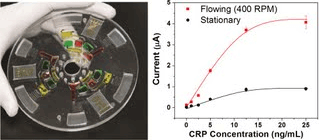
[40] Lab Chip, 13, 3747-3754 (2013)
We present a novel fullyintegrated centrifugal microfluidic devicewith features for target antigen capture from biological samples, via a bead-based enzyme-linkedimmune-sorbent assay, and flow-enhanced electrochemicaldetection.

[39] Lab Chip, 13, 3253-3260 (2013)
We demonstrate that electrochemical velocimetry is a straightforward technique to accurately monitor flow on rotating microfluidic platforms in real-time.

[38] Anal. Chem., 85 (5), 2954–2960 (2013)
We introduce a new fully integrated centrifugal microfluidic device for simultaneous determination of five major inorganic nutrients: nitrite, nitrate+nitrite, ammonium, orthophosphate, and silicate.
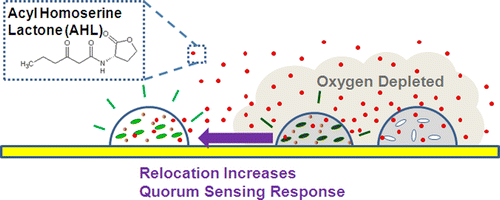
[37] JACS, 135, 6, 2242–2247 (2013)
This paper describes a system to study how small physical perturbations can affect bacterial community behavior in unexpected ways through modulation of diffusion and convective transport of chemical communication molecules and resources

[36] Sensors & Actuators: B. Chemical, 178, 648-655 (2013)
The geometric factors for faster particle separation rate on a centrifugal microfluidic platform are described

[35] Biomedical Microdevices, 15, 4, 627-634 (2013)
This report presents a multilevel microfluidic platform for robust construction of hydrogel scaffold in microchannels and its application to three dimensional (3D) multicellular co-cultures and assays.

[34] ACS Appl. Mater. Interfaces, 4(12) 6537-6544 (2012)
A possible mechanism for the aminosilane-mediated room-temperature (RT) bonding of thermoplastics and poly(dimethylsiloxane) (PDMS) is presented.

[33] RSC Advances, 2, 9066-9070 (2012)
We report a versatile method for bonding dissimilar materials which is an important issue in the fabrication of micro- and nanofluidic devices.

[32] ACS Appl. Mater. Interfaces, 4(12) 6537-6544 (2012)
We describe patterning of bacterial biofilms using polymer-based aqueous two-phase system (ATPS) microprinting protocols.

[31] Anal. Chem., 84 (5), 2133–2140 (2012)
This paper presents a cost-effective, rapid, and fully automated lab-on-a-disc for simultaneous detection of multiple protein biomarkers in raw samples such as whole blood or whole saliva.

[30] ACS Appl. Mater. Interfaces, 4 (1), 34–39 (2012)
Single suspended carbon nanowires (CNWs) integrated on carbon-MEMS (CMEMS) structures are fabricated by electrospinning of SU-8 photoresist followed by pyrolysis.

[29] Carbon, 50(5), 1753–1761 (2012)
Single suspended carbon nanofibers on carbon micro-structures were fabricated by direct electrospinning and subsequent pyrolysis at 900 °C of carbon nanotube/polyacrylonitrile (CNT/PAN) composite material.
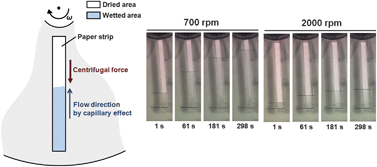
[28] Lab Chip, 11, 3404-3406 (2011)
This paper describes the active control of the capillary-driven flow in paper using a centrifugal device.

[27] Lab Chip, 11, 2518-2525 (2011)
In situ measurements of the enhanced SERS signal are demonstrated by using dynamic SERS active sites resulted from optically induced electrokinetic mechanisms.

[26] Microfluidics and Nanofluidics, 11(5), 643-652 (2011)
we present a novel pumping technique for the centrifugal microfluidic disc platform, termed the thermo-pneumatic pump (TPP), that enables fluids to be transferred the center of a rotating disc by the thermal expansion of air.

[25] Lab Chip, 11 (8), 1434 - 1436 (2011)
We present elastomeric membrane valves integrated into a centrifugal microfluidic platform for precise control of fluid on a disc.

[24] Chem. Soc. Rev. 40, 3677-3702, (2011)
The fabrication of nanochannels in thermoplastics and elastomers is critically reviewed along with their potential applications.

[23] Lab Chip, 11, 962-965 (2011)
We report a simple, versatile, instantaneous and irreversible method for bonding thermoplastics to elastomeric polydimethylsiloxane (PDMS) at room temperature.

[22] Lab Chip, 1170-78 (2011)
We report a fully integrated lab-on-a-disc system for simultaneous analysis of clinical chemistry and enzyme-linked immuno-sorbent assay (ELISA) from whole blood.
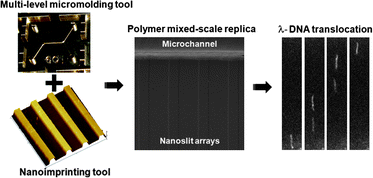
[21] Lab Chip, 10, 3255-3264 (2010)
Distinct elastic interface of surface microfluidics enables novel three-dimensional (deformable) and time-dependent (capacitive) operations of the surface flow.

[20] J. Micromech. Microeng., 065010, (2010)
We report the on-chip concentration of bacteria using a dielectrophoretic (DEP) chip with 3D electrodes and subsequent laser-based DNA extraction in the same chip.

[19] Lab Chip, 1758-1773, (2010)
This paper presents an in-depth review of the centrifugal microfluidic platform for biomedical applications, while highlighting recent progress in the field and outlining the potential for future applications.

[18] Annals of Biomedical Engineering, 38, 2056–2067 (2010)
Microfabrication technologies have a high potential for novel approaches to access living cells at a cellular or even at a molecular level.

[17] Electrophoresis, 30, 3153–3159 (2009)
We report an insulator-based (or, electrodeless) dielectrophoresis utilizing microfabricated plastic membranes.

[16] Lab Chip, 9, 1548-1555 (2009)
We report a disc-based and fully automated microfluidic enzyme-linked immuno-sorbent assay (ELISA) system for the quantification of proteins from whole blood.

[15] Lab Chip, 7, 565-573 (2007)
We report a fully integrated, pathogen-specific DNA extraction CD platform utilizing innovative laser irradiated ferrowax microvalves (LIFM) and the rapid cell lysis method using target separation and laser-irradiated magnetic bead system (TS-LIMBS).
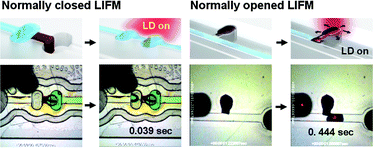
[14] Lab Chip, 7, 557-564, (2007)
We report a novel phase change based microvalve for rapid and versatile operation of multiple microvalves using nanoheaters, 10 nm-sized iron oxide nanoparticles dispersed in paraffin wax, and laser irradiation.

[13] Colloids and Surfaces A: Physicochem. Eng. Aspects, 294, 228-235 (2006)

[12] Microsystem Technologies, 12, 238-246 (2006)

[11] Biosensors and Bioelectronics, 21, 2161-2169, (2006)

[10] Lab Chip, 8, 845-850, (2005)

[09] J. Micromech. Microeng. 15(3), 455-462 (2005)

[08] Journal of Colloid Interface and Science, 278, 44-52 (2004 )

[07] J. Chemical Physics, 119,1,547-554 (2003)

[06] Langmuir, 17, 7732-7734 (2001)

[05] J. Chem. Phys, 110, 9688-9696 (1999)

[04] J. of Polymer Science: Part B: Polymer Physics, 35, 2961-2968 (1997)

[03] Tribology Intl., 30, 12, 889-894 (1997)

[02] Wear, 200, 346-352 (1996)

[01] J. Membrane Science, 104, 3, 219-230 (1995)



























